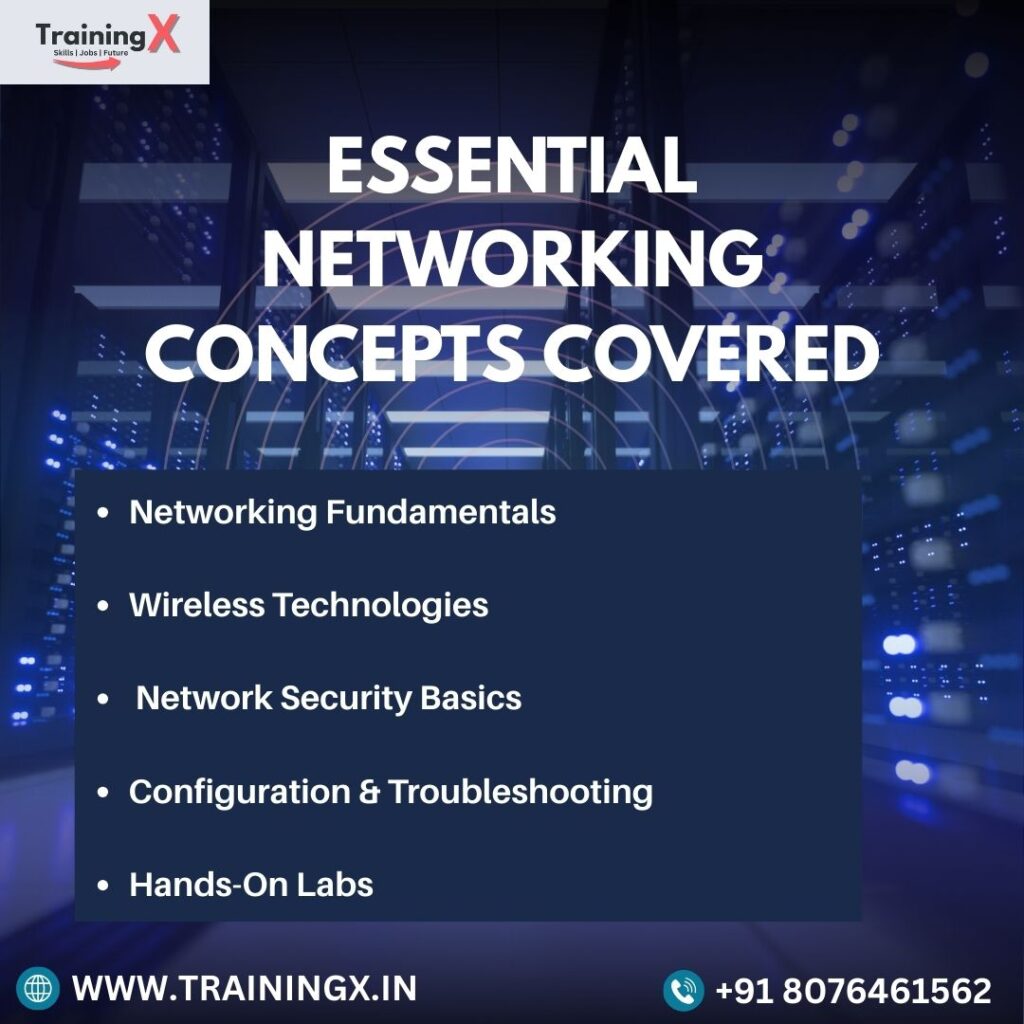Struggling to keep up in the fast-moving tech world where everything is going wireless? You’re not alone. As businesses shift to cloud-based systems, IoT, and remote operations, there’s a growing demand for professionals who understand wireless networking. Yet, many IT aspirants lack the specialized skills to stand out in this competitive market. That’s where the Wireless Networking Certification Course comes in. It bridges the gap between basic networking knowledge and real-world wireless expertise. With TrainingX, you gain practical training designed to make you job-ready from day one.
What is a Wireless Networking Certification?
Wireless networking is a method of connecting devices such as computers, smartphones, and tablets without the use of physical cables. Instead, it utilizes radio frequency signals to transmit data between devices. As a result, it enables seamless communication and internet access. Moreover, this technology is foundational in modern networking, as it allows for greater mobility, flexibility, and scalability. Consequently, wireless networking is widely adopted in various environments, ranging from homes to large enterprises.
Wireless networking is a critical component of the CCNA Training & Certification Program offered by TrainingX. The program provides comprehensive training on configuring, managing, and securing wireless networks, aligning with industry standards, and preparing students for real-world networking challenges.
Is Wireless Networking the Right Path for You?
Choosing a career isn’t always easy. However, if you’re interested in technology, enjoy solving problems, and want to work in a growing field, then wireless networking might be the perfect choice for you. Wireless networking is all around us. From smartphones and laptops to smart homes and cloud systems, nearly everything today relies on wireless connections. Therefore, understanding and mastering this technology can open the door to a wide range of career opportunities.
- Increasing demand for wireless professionals across industries
- Work in cutting-edge areas like IoT, 5G, and enterprise networking
- High-paying job roles in tech, telecom, education, and defense
- Flexibility to work in on-site and remote roles
Essential Networking Concepts Covered
The curriculum of this course is carefully designed to balance theory with real-world application. Here are the core topics usually covered:

- Networking Fundamentals
Networking fundamentals cover the basic concepts and rules that explain how computers and devices connect, communicate, and share resources. This includes understanding different types of networks, layouts (topologies), hardware devices, communication protocols, and basic security measures. - Wireless Technologies
Wireless technology refers to the transmission of data and information using electromagnetic waves instead of physical wires or cables. As a result, this technology enables devices to communicate and exchange data wirelessly. Furthermore, it offers flexibility and convenience across various applications, ranging from mobile phones to Internet of Things (IoT) devices. Consequently, wireless technology plays a crucial role in modern communication and connectivity.
- Network Security Basics Network security refers to safeguarding a computer network and its data from unauthorized access, misuse, disclosure, disruption, alteration, or destruction. This is achieved through a combination of hardware, software, and policies. Key aspects include securing access to the network, protecting data in transit and at rest, and monitoring for and responding to security incidents.
- Configuration & Troubleshooting Configuration involves setting up network components like IP addresses, routers, switches, and security measures such as firewalls and encryption to ensure a stable network. Troubleshooting focuses on identifying and fixing issues like slow performance, connectivity problems, or hardware faults to keep the network running smoothly.
- Hands-On Labs TrainingX’s CCNA program offers hands-on labs that simulate real networking environments, enabling students to configure routers, switches and apply network security measures.
Tools You’ll Use in Real-World Scenarios
At TrainingX, you don’t just learn the theory—you also get practical experience using real networking tools that professionals use every day. Here’s what you’ll work with:
- Cisco Packet Tracer
Cisco Packet Tracer is an advanced network simulation software developed by Cisco. It is intended for students and professionals to practice networking concepts. It allows you to create, configure, and troubleshoot complex network setups in a virtual environment without the need for physical hardware. - Cisco Routers & Switches
Cisco Routers and Switches are essential tools used to build and manage reliable, high-performance networks. Routers connect different networks and manage traffic between them, while switches connect multiple devices within the same network, allowing them to communicate efficiently.
- Command Line Interface (CLI)
Cybersecurity and network professionals use the Command Line Interface (CLI) as a powerful tool to interact directly with an operating system or device through typed commands. - Network Monitoring Tools
Network Monitoring Tools help keep a constant watch on a computer network’s performance, ensuring its smooth operation by analyzing, managing, and detecting issues in real time.
Who Should Enroll in This Course?
A wireless networking certification course is ideal for:
- Fresh graduates from B.Tech/BCA/MCA backgrounds
- Working IT professionals aiming to upskill
- Aspiring network engineers or CCNA hopefuls
- Individuals looking to transition into cybersecurity or cloud
Opportunities Beyond the Certification
Obtaining a CCNA certification enhances your networking knowledge and opens up various IT career opportunities:
Network Administrator:
Network Administrators oversee the daily functioning of an organization’s computer networks, ensuring they run efficiently, securely, and without interruptions. Their duties include installing and configuring network hardware and software, monitoring network performance, ensuring security protocols are in place, and troubleshooting any network issues to ensure seamless connectivity.
Network Engineer:
Network Engineers focus on designing, implementing, and managing complex network infrastructures. They assess organizational needs to develop tailored network solutions, handle the installation of network hardware, optimize network performance, and address any technical challenges to maintain robust and efficient networks.
IT Support Specialist:
IT Support Specialists provide technical assistance for computer systems, hardware, and software. They address user inquiries, troubleshoot technical issues, assist with software installations, and ensure that IT systems operate efficiently to support organizational needs.
Final Thoughts
Investing in a Wireless Infrastructure Certification is more than just learning technology—it’s about creating a career that evolves with the future. Whether you’re an aspiring IT professional or looking for a career switch, this course equips you with the technical mastery to stand out. At TrainingX, we’re not just training students—we’re building tomorrow’s network experts. Enroll today and take the first step toward a rewarding IT career. Ready to future-proof your career? Enroll in our Wireless Networking Certification Course at TrainingX today!
